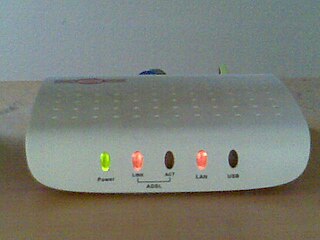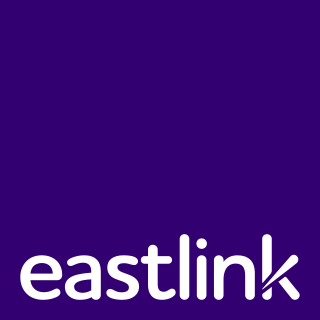Related Research Articles

Wireless broadband is telecommunications technology that provides high-speed wireless Internet access or computer networking access over a wide area. The term comprises both fixed and mobile broadband.

Telecommunications in Australia refers to communication in Australia through electronic means, using devices such as telephone, television, radio or computer, and services such as the telephony and broadband networks. Telecommunications have always been important in Australia given the 'tyranny of distance' with a dispersed population. Governments have driven telecommunication development and have a key role in its regulation.

Multichannel Multipoint Distribution Service (MMDS), formerly known as Broadband Radio Service (BRS) and also known as Wireless Cable, is a wireless telecommunications technology, used for general-purpose broadband networking or, more commonly, as an alternative method of cable television programming reception.

Internet access is the ability of individuals and organizations to connect to the Internet using computer terminals, computers, and other devices; and to access services such as email and the World Wide Web. Internet access is sold by Internet service providers (ISPs) delivering connectivity at a wide range of data transfer rates via various networking technologies. Many organizations, including a growing number of municipal entities, also provide cost-free wireless access and landlines.

A wireless Internet service provider (WISP) is an Internet service provider with a network based on wireless networking. Technology may include commonplace Wi-Fi wireless mesh networking, or proprietary equipment designed to operate over open 900 MHz, 2.4 GHz, 4.9, 5, 24, and 60 GHz bands or licensed frequencies in the UHF band, LMDS, and other bands from 6 GHz to 80 GHz.

G.992.5 is an ITU-T standard for asymmetric digital subscriber line (ADSL) broadband Internet access. The standard has a maximum theoretical downstream sync speed of 24 Mbit/s. Utilizing G.992.5 Annex M upstream sync speeds of 3.3 Mbit/s can be achieved.

Eastlink Inc. is a Canadian cable television and telecommunications company. The privately held company was founded in Nova Scotia in 1969 by the Bragg family, and has grown since through the amalgamation of several telecommunications companies.
Access Communications is a Canadian telecommunications service provider operating in over 235 communities in Saskatchewan. Headquartered in Regina, the co-operative provides internet, cable television, telephone and security services to residential and business customers. Its primary competitor is Saskatchewan's government-owned SaskTel.
Internet in Australia first became available on a permanent basis to universities in Australia in May 1989, via AARNet. Pegasus Networks was Australia's first public Internet provider in June 1989. The first commercial dial-up Internet Service Provider (ISP) appeared in capital cities soon after, and by the mid-1990s almost the entire country had a range of choices of dial-up ISPs. Today, Internet access is available through a range of technologies, i.e. hybrid fibre coaxial cable, digital subscriber line (DSL), Integrated Services Digital Network (ISDN) and satellite Internet. In July 2009, the federal government, in partnership with the industrial sector, began rolling out a nationwide fibre-to-the-premises (FTTP) and improved fixed wireless and satellite access through the National Broadband Network. Subsequently, the roll out was downgraded to a Multi-Technology Mix on the promise of it being less expensive and with earlier completion. In October 2020, the federal government announced an upgrade by 2023 of NBN fibre-to-the-node (FTTN) services to FTTP for 2 million households, at a cost of A$3.5 billion.
Internet access is widely available in New Zealand, with 93% of New Zealanders having access to the internet as of January 2020. It first became accessible to university students in the country in 1989. As of June 2018, there are 1,867,000 broadband connections, of which 1,524,000 are residential and 361,000 are business or government.

The Internet in the United States grew out of the ARPANET, a network sponsored by the Advanced Research Projects Agency of the U.S. Department of Defense during the 1960s. The Internet in the United States in turn provided the foundation for the worldwide Internet of today.

Canada ranks as the 21st in the world for Internet usage with 31.77 million users as of July 2016 (est), making up 89.8% of the population. According to Harvard researchers, Canada has some of the lowest internet standards among OECD countries, as a result of high costs and slow internet speeds.
In telecommunications, white spaces refer to radio frequencies allocated to a broadcasting service but not used locally. National and international bodies assign frequencies for specific uses and, in most cases, license the rights to broadcast over these frequencies. This frequency allocation process creates a bandplan which for technical reasons assigns white space between used radio bands or channels to avoid interference. In this case, while the frequencies are unused, they have been specifically assigned for a purpose, such as a guard band. Most commonly however, these white spaces exist naturally between used channels, since assigning nearby transmissions to immediately adjacent channels will cause destructive interference to both.
Rural Internet describes the characteristics of Internet service in rural areas, which are settled places outside towns and cities. Inhabitants live in villages, hamlets, on farms and in other isolated houses. Mountains and other terrain can impede rural Internet access.
This article lists the deployment of fiber to the premises, fiber to the home and fiber to the building by country.

SSi Canada is a Canadian wireless broadband internet service provider primarily serving remote areas that lack terrestrial service options. SSi was established in 1990 by Jeffrey Philipp and is headquartered in Yellowknife, capital of the Northwest Territories. SSi is also a provider of Satellite Communication services, offered in locations that do not have terrestrial service options. They offer turnkey Internet systems to other ISPs. They have a local market serving all 25 communities in Nunavut and several in the Northwest Territories. These two territories account for 1/3 of Canada's landmass covering 3,439,296 km2 (1,327,920 sq mi). They also have an international market including Africa, Indonesia and Kiribati.

Broadband is a term normally considered to be synonymous with a high-speed connection to the internet. Suitability for certain applications, or technically a certain quality of service, is often assumed. For instance, low round trip delay would normally be assumed to be well under 150ms and suitable for Voice over IP, online gaming, financial trading especially arbitrage, virtual private networks and other latency-sensitive applications. This would rule out satellite Internet as inherently high-latency. In some applications, utility-grade reliability or security are often also assumed or defined as requirements. There is no single definition of broadband and official plans may refer to any or none of these criteria.
Seaside Communications is a Canadian cable television and telecommunications company. In 1975, Seaside was established in Sydney, Nova Scotia, when it was issued a cable licence from the CRTC.
BharatNet, also known as Bharat Broadband Network Limited, is a government-owned broadband infrastructure provider, set up by the Department of Telecommunications, a department under Ministry of Communications of the Government of India for the establishment, management, and operation of the National Optical Fibre Network to provide a minimum of 100 Mbit/s broadband connectivity to all 250,000-gram panchayats in the country, covering nearly 625,000 villages, by improving the middle layer of nation-wide broadband internet in India to achieve the goal of Digital India.
References
- ↑ Nova Scotia Department of Economic and Rural Development press release, May 2006
- ↑ Sources for data compiled from Statistics Canada and Connected Nation, USA
- ↑ Canadian Internet Use Survey, 2005
- ↑ Dept of Economic Development press release, 2006
- ↑ "Archived copy" (PDF). Archived from the original (PDF) on 2015-12-10. Retrieved 2015-12-10.CS1 maint: archived copy as title (link)
- ↑ see Seaside Wireless website for details of coverage to date
- ↑ see EastLink website for details of coverage to date
- ↑ "N.S. rural broadband deadline looming". CBC News. November 19, 2009.
- ↑ Myrden, Judy (8 June 2010). "Wireless in next 6 weeks". The Chronicle Herald. Archived from the original on June 11, 2010. Retrieved 16 June 2010.
- ↑ http://thechronicleherald.ca/Business/1166625.html [ bare URL ]
- ↑ "Archived copy" (PDF). Archived from the original (PDF) on 2015-12-10. Retrieved 2015-12-10.CS1 maint: archived copy as title (link)
- ↑ http://whatsyourtech.ca/2013/07/22/her-leadership-on-high-speed-internet-project-puts-canadian-province-on-top/
- ↑ http://thechronicleherald.ca/novascotia/1190230-residents-band-together-on-internet-woes [ bare URL ]
- ↑ http://www.cbc.ca/news/canada/nova-scotia/eastlink-behind-on-rural-broadband-1.1128582 [ bare URL ]
- ↑ https://www.theglobeandmail.com/news/politics/nova-scotia-gives-internet-provider-deadline-for-rural-broadband-project/article17002963/ [ bare URL ]
- ↑ https://ca.news.yahoo.com/eastlink-cap-rural-internet-usage-140534131.html